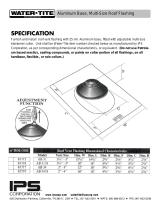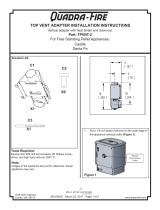
4
CLEARANCES AND APPLICATIONS
Simpson Dura-Vent’s PelletVent Pro is listed
by Underwriters Laboratories as vent for listed
appliances that burn oil, pellet, corn, and other
biofuels. PelletVent Pro is also listed as a
masonry reliner with the minimum clearance
is 0” from vent to masonry, and 0” clearance
from the masonry to nearby combustibles.
Never ll any required clearance space with
insulation or any other materials. Combustible
materials include (but are not limited to)
lumber, plywood, sheetrock, plaster and
lath, furniture, curtains, electrical wiring, and
building insulation of any kind.
In the United States and Canada the minimum
clearance to combustibles from PelletVent
Pro is 1” for oil, pellet, corn or other agri-fuel
applications.
VENT LISTING
PelletVent Pro is listed by Underwriters
Laboratories (listing numbers MH8381 &
MH14420) to the American standard UL 641
Type L Low Temperature Venting Systems,
and is also listed to the Canadian standards
ULC S609 Standard for Low Temperature
Vents Type L and ULC/ORD-C441 Standard
for PelletVent.
INSTALLATION NOTES
Proper planning for your PelletVent Pro
installation will result in greater safety,
efciency, and convenience, saving both time
and money. Use only authorized Simpson
Dura-Vent PelletVent, CornVent, and
PelletVent Pro biofuel listed parts. Do not
install damaged parts.
1. WARNING: When passing through ceilings
and walls, make sure all combustible materials
and building insulation products are a
minimum of 1” from the vent pipe
2. For horizontal terminations, make sure
NFPA 211 rules are followed for minimum
distance from windows and openings.
3. Do not mix and match with other
manufacturer’s products or improvised
solutions.
4. Practice good workmanship. Sloppy
work could jeopardize your PelletVent Pro
installation.
5. Never use a vent with an inside diameter
that is smaller than the appliance ue outlet.
6. Multistory: Where PelletVent Pro passes
through the ceiling, use Simpson Dura-Vent
Firestop/Support assembly.
7. PelletVent Pro placement: When deciding
the location of your stove and vent, try to
minimize the alteration and reframing of
structural components of the building.
8. Sections of pipe are connected to each
other by pushing them rmly together and
twisting. Screws are not required. However, if
screws are desired, use 1/4”-long sheet metal
screws. Important! Do not penetrate the inner
liner with screws.
9. Never install single-wall pipe to freestanding
pellet stoves. Single-wall pipe may be
connected to a replace insert, provided it
is inside the replace, and the replace has
completely sealed surroundings.
10. Do not connect Type B Gas Vent pipe with
aluminum liners to pellet appliances.
LUBRICANTS & GASKETS
Newer PelletVent Pro utilizes an internal O-ring
gasket on the outside of the inner liner in the
female end of the Pipe Section. These gaskets
are lubricated and help seal Pipe Sections as
they are connected together. If your O-ring
gasket is missing or it becomes unseated
during connection, you must replace and
http://www.northlineexpress.com





















